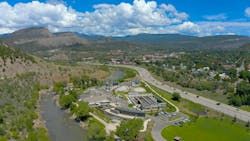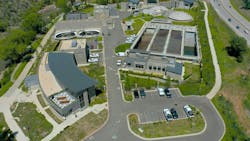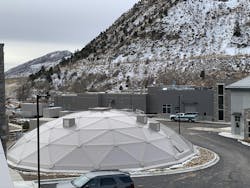In Colorado, the City of Durango’s Santa Rita Water Reclamation Facility was originally built in 1952 and is situated on a 5.5-acre site alongside the scenic Animas River in the southwest region of the state.
Last updated in the mid-1980s, the plant had been operating near its capacity in the face of increasing maintenance challenges while struggling to meet effluent limits. The population of Durango consists of approximately 17,000 residents, but it can double on a daily basis due to an influx of tourists, college students, employees, and other visitors.
With a treatment capacity of 3 million gallons per day (MGD), the city recognized the need to expand and modernize the plant to comply with future effluent regulatory nutrient (nitrogen and phosphorus) standards and accommodate the expected growth of Durango’s surrounding community.
Expansion in a small footprint
Of particular concern were odors emitted by the plant. Given its proximity to popular recreational amenities such as the Animas River Trail, Santa Rita Park, and the renowned Durango Whitewater Park, odor mitigation and odor control emerged as a priority from the start.
The city initially explored several potential sites as relocation options, but ultimately determined that upgrading the plant at its current location presented the most cost-effective solution. Following a competitive bid process, Dewberry was awarded the contract to design the upgraded facility, which would expand the plant’s capacity to 3.26 MGD while mostly retaining its existing footprint.
Additional objectives of the upgrade included protecting the water quality of the Animas River and complying with Colorado’s Regulation 85, the Nutrients Management Control Regulation, which sets effluent nutrient discharge limits for treatment plants.
Dewberry prepared a nutrient report, including planning level criteria for improvements, based on projected growth and regulatory requirements. An alternatives analysis with a preliminary opinion of probable construction cost and estimated operation and maintenance cost for each alternative was also developed in addition to an implementation plan for the recommended alternatives.
Community engagement shapes plant design
Addressing community concerns regarding the new facility’s impact on adjacent high-profile recreational sites was crucial to the success of the project.
Dewberry collaborated closely with the city, conducting extensive outreach that involved a series of design charrettes, public workshops, and meetings over an eight-month period. The process allowed community members to voice their concerns regarding odors, encroachment, and visual impact within the scenic setting. These inputs were carefully addressed in the final design.
The project’s 17,000-square-foot administration building, designed to LEED Gold standards, features visually appealing architecture that includes native stone and glass and a green roof. Additionally, educational exhibits highlight the plant’s state-of-the-art treatment process. Dewberry designed the facility to blend with the park environment and natural surroundings, and the building now serves as an attractive gateway to the site and a community amenity.
The plant incorporates new odor control technology, including cost-effective primary and secondary odor mitigation and treatment processes that either pretreat the air or contain and treat odorous air. At identified major odor-generating locations (headworks, primary clarifiers, and digester support), an iron-impregnated activated carbon system captures and treats odorous air before it is released to the atmosphere.
Activated carbon is a versatile, porous substance that attracts and contains odors, and the addition of iron enhances the carbon’s ability to remove sulfide-based odor compounds, such as hydrogen sulfide and mercaptans.
A second process employed at odor-generating locations consists of an air pretreatment system that utilizes ultraviolet light to produce hydroxl radicals that attack double bonds common in many odor compounds. In this way, the process eliminates or reduces the presence of odor compounds at the source.
Together, these technologies have significantly reduced odors which were previously a chronic issue. Since coming online, the upgraded facility has had only one odor complaint, while prior to the upgrades, the plant was receiving one to two odor complaints per month.
Engineered for long-term sustainability
Dewberry integrated multiple design concepts into the facility upgrade to maximize the efficiency of the treatment processes, meet desired effluent requirements, and support the project’s energy resiliency well into the future.
The new aeration system combines energy-efficient, high speed turbo blowers available with a diffuser and control system that optimizes oxygen transfer while minimizing energy consumption. A custom-designed Johannesburg process biologically removes nitrogen and phosphorus from the water, and the facility now produces effluent that meets and exceeds regulatory effluent requirements for nitrogen and phosphorus.
New linear motion mixers in the anaerobic digesters require one-third the horsepower of conventional mixing technologies. Primary clarifiers collect carbon-rich solids from influent wastewater, which is then sent to anaerobic digesters for treatment.
Renewable, methane-rich biogas recovered from the digestion process is scrubbed for use in a cogeneration system that supplies heat to the digesters, reducing digester natural gas demand by 60 to 80%, and produces enough electricity to reduce outside energy demand by 40%.
During the design process, influent biochemical oxygen demand/carbon oxygen demand (BOD5/COD) was fractionated to optimize the treatment process, yielding a high-quality effluent with minimal chemical and energy use.
The result is a water reclamation facility that consumes less energy than similar-sized facilities to produce a high-quality effluent. Effluent nutrient concentrations are sufficiently low so as to postpone future regulatory requirements for 10 years.
Design enhancements throughout the plant
Additional project features include biosolids dewatering, dewatering supernatant treatment, a blower and chemical building, and new process pumps with return activated sludge and waste activated sludge and scum in the treatment complex.
Dewberry also provided supervisory control and data acquisition (SCADA) programming, BioWin model development, BioWin model calibration of existing treatment processes, as well as process optimization and operational support. With these enhancements, the City of Durango’s Santa Rita Water Reclamation Facility is equipped to accommodate more than 20 years of projected growth. Moreover, the improvements will enable the city to defer millions of dollars in treatment infrastructure upgrade costs until 2042.
The $64.2 million upgrade was made possible by a $59.7 million loan from the Colorado Water Resources and Power Development Authority State Revolving Fund (SRF) and a second loan of $2.5 million from the Colorado Water Resources and Power Development Authority SRF Green Project Reserve. The city also received a $2 million grant from the Colorado Department of Local Affairs Energy Impact Assistance Fund for construction.
“The end product of construction was that we met our nutrient standard regulations on day one of receiving our permit, and that was very exciting,” says Jarrod Biggs, the former assistant financial director for the City of Durango. “It was the culmination of a lot of effort, forethought, and planning.”
About the Author
Patrick Radabaugh
associate vice president and chief engineer for Dewberry
Patrick Radabaugh is associate vice president and chief engineer for Dewberry.


